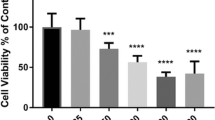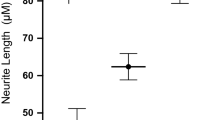Abstract
There is a strong body of evidence linking the non-protein amino acid (NPAA) β-methylamino-l-alanine (BMAA) to the development of a number of neurodegenerative diseases. BMAA has been found globally, is produced by a number of organisms including cyanobacteria, diatoms, and dinoflagellates; and has been shown to biomagnify through trophic levels. The role of BMAA in neurodegenerative disease is highlighted by its presence in the brains of a number of neurodegenerative disease patients, where it was found in a protein-bound form. We have previously shown that BMAA is bound to cell proteins, and results in the upregulation of the unfolded protein response, an endoplasmic reticulum stress response activated by the presence of misfolded proteins within the cell. Structurally aberrant proteins are features of a number of neurodegenerative diseases, and further investigation of how BMAA interacts with proteins is crucial to our understanding of its toxicity. Here we use radiolabelled BMAA to investigate the interaction and binding of BMAA to eukaryotic and prokaryotic proteins. We found differences in the presence and distribution of protein-bound BMAA between E. coli and neuroblastoma cells, with an increase in binding over time only seen in the eukaryotic cells. We also found that BMAA was unable to bind to pure proteins, or cell lysate in native or denaturing conditions, indicating that biological processing is required for BMAA to bind to proteins.









Similar content being viewed by others
References
Banack SA, Caller T, Henegan P, Haney J, Murby A, Metcalf JS, Powell J, Cox PA, Stommel E (2015) Detection of cyanotoxins, beta-N-methylamino-l-alanine and microcystins, from a lake surrounded by cases of amyotrophic lateral sclerosis. Toxins (Basel) 7(2):322–336. https://doi.org/10.3390/toxins7020322
Berntzon L, Erasmie S, Celepli N, Eriksson J, Rasmussen U, Bergman B (2013) BMAA inhibits nitrogen fixation in the cyanobacterium Nostoc sp. PCC 7120. Mar Drugs 11(8):3091–3108. https://doi.org/10.3390/md11083091
Britten RJ, McClure FT (1962) The amino acid pool in Escherichia Coli. Bacteriol Rev 26(3):292–335
Caller TA, Doolin JW, Haney JF, Murby AJ, West KG, Farrar HE, Ball A, Harris BT, Stommel EW (2009) A cluster of amyotrophic lateral sclerosis in new hampshire: a possible role for toxic Cyanobacteria blooms. Amyotroph Lateral Scler 10(Suppl 2):101–108. https://doi.org/10.3109/17482960903278485
Chiu AS, Gehringer MM, Braidy N, Guillemin GJ, Welch JH, Neilan BA (2012) Excitotoxic potential of the cyanotoxin beta-methyl-amino-l-alanine (BMAA) in primary human neurons. Toxicon 60(6):1159–1165. https://doi.org/10.1016/j.toxicon.2012.07.169
Chiu AS, Gehringer MM, Braidy N, Guillemin GJ, Welch JH, Neilan BA (2013) Gliotoxicity of the cyanotoxin, beta-methyl-amino-l-alanine (BMAA). Sci Rep 3:1482. https://doi.org/10.1038/srep01482
Chiu AS, Braidy N, Marcal H, Welch JH, Gehringer MM, Guillemin GJ, Neilan BA (2015) Global cellular responses to beta-methyl-amino-l-alanine (BMAA) by olfactory ensheathing glial cells (OEC). Toxicon 99:136–145. https://doi.org/10.1016/j.toxicon.2015.03.009
Cox PA, Banack SA, Murch SJ, Rasmussen U, Tien G, Bidigare RR, Metcalf JS, Morrison LF, Codd GA, Bergman B (2005) Diverse taxa of cyanobacteria produce beta-N-methylamino-l-alanine, a neurotoxic amino acid. Proc Natl Acad Sci USA 102(14):5074–5078. https://doi.org/10.1073/pnas.0501526102
Cox PA, Richer R, Metcalf JS, Banack SA, Codd GA, Bradley WG (2009) Cyanobacteria and BMAA exposure from desert dust: a possible link to sporadic ALS among Gulf War veterans. Amyotroph Lateral Scler 10(Suppl 2):109–117. https://doi.org/10.3109/17482960903286066
Cox PA, Davis DA, Mash DC, Metcalf JS, Banack SA (2016) Dietary exposure to an environmental toxin triggers neurofibrillary tangles and amyloid deposits in the brain. Proc Biol Sci. https://doi.org/10.1098/rspb.2015.2397
Downing S, van de Venter M, Downing TG (2012) The effect of exogenous beta-N-methylamino-l-alanine on the growth of Synechocystis PCC6803. Microb Ecol 63(1):149–156. https://doi.org/10.1007/s00248-011-9958-9
Duggin IG, Aylett CH, Walsh JC, Michie KA, Wang Q, Turnbull L, Dawson EM, Harry EJ, Whitchurch CB, Amos LA, Lowe J (2015) CetZ tubulin-like proteins control archaeal cell shape. Nature 519(7543):362–365. https://doi.org/10.1038/nature13983
Dunlop RA, Dean RT, Rodgers KJ (2008) The impact of specific oxidized amino acids on protein turnover in J774 cells. Biochem J 410(1):131–140. https://doi.org/10.1042/BJ20070161
Dunlop RA, Cox PA, Banack SA, Rodgers KJ (2013) The non-protein amino acid BMAA is misincorporated into human proteins in place of l-serine causing protein misfolding and aggregation. PLoS One 8(9):e75376. https://doi.org/10.1371/journal.pone.0075376
Evans GA (1990) Molecular cloning: A laboratory manual. 2nd edn. Vol 1, 2, and 3. Current protocols in molecular biology. Volumes 1 and 2, vol 61. Cell, vol 1. https://doi.org/10.1016/0092-8674(90)90210-6
Jiang L, Eriksson J, Lage S, Jonasson S, Shams S, Mehine M, Ilag LL, Rasmussen U (2014a) Diatoms: a novel source for the neurotoxin BMAA in aquatic environments. PLoS One 9(1):e84578. https://doi.org/10.1371/journal.pone.0084578
Jiang L, Kiselova N, Rosen J, Ilag LL (2014b) Quantification of neurotoxin BMAA (beta-N-methylamino-l-alanine) in seafood from Swedish markets. Sci Rep 4:6931. https://doi.org/10.1038/srep06931
Johnson HE, King SR, Banack SA, Webster C, Callanaupa WJ, Cox PA (2008) Cyanobacteria (Nostoc commune) used as a dietary item in the Peruvian highlands produce the neurotoxic amino acid BMAA. J Ethnopharmacol 118(1):159–165. https://doi.org/10.1016/j.jep.2008.04.008
Jonasson S, Eriksson J, Berntzon L, Spacil Z, Ilag LL, Ronnevi LO, Rasmussen U, Bergman B (2010) Transfer of a cyanobacterial neurotoxin within a temperate aquatic ecosystem suggests pathways for human exposure. Proc Natl Acad Sci USA 107(20):9252–9257. https://doi.org/10.1073/pnas.0914417107
Lage S, Costa PR, Moita T, Eriksson J, Rasmussen U, Rydberg SJ (2014) BMAA in shellfish from two Portuguese transitional water bodies suggests the marine dinoflagellate Gymnodinium catenatum as a potential BMAA source. Aquat Toxicol 152:131–138. https://doi.org/10.1016/j.aquatox.2014.03.029
Lobner D (2009) Mechanisms of beta-N-methylamino-l-alanine induced neurotoxicity. Amyotroph Lateral Scler 10(Suppl 2):56–60. https://doi.org/10.3109/17482960903269062
Main BJ, Dunlop RA, Rodgers KJ (2016) The use of l-serine to prevent beta-methylamino-l-alanine (BMAA)-induced proteotoxic stress in vitro. Toxicon 109:7–12. https://doi.org/10.1016/j.toxicon.2015.11.003
Masseret E, Banack S, Boumediene F, Abadie E, Brient L, Pernet F, Juntas-Morales R, Pageot N, Metcalf J, Cox P, Camu W, French Network on ALSCD Investigation (2013) Dietary BMAA exposure in an amyotrophic lateral sclerosis cluster from southern France. PLoS One 8(12):e83406. https://doi.org/10.1371/journal.pone.0083406
Murch SJ, Cox PA, Banack SA (2004a) A mechanism for slow release of biomagnified cyanobacterial neurotoxins and neurodegenerative disease in Guam. Proc Natl Acad Sci USA 101(33):12228–12231. https://doi.org/10.1073/pnas.0404926101
Murch SJ, Cox PA, Banack SA, Steele JC, Sacks OW (2004b) Occurrence of beta-methylamino-l-alanine (BMAA) in ALS/PDC patients from Guam. Acta Neurol Scand 110(4):267–269. https://doi.org/10.1111/j.1600-0404.2004.00320.x
Nunn PB, O’Brien P (1989) The interaction of β-N-methylamino-l-alanine with bicarbonate: an 1H-NMR study. FEBS Lett 251(1–2):31–35
Okle O, Stemmer K, Deschl U, Dietrich DR (2013) L-BMAA induced ER stress and enhanced caspase 12 cleavage in human neuroblastoma SH-SY5Y cells at low nonexcitotoxic concentrations. Toxicol Sci 131(1):217–224. https://doi.org/10.1093/toxsci/kfs291
Pablo J, Banack SA, Cox PA, Johnson TE, Papapetropoulos S, Bradley WG, Buck A, Mash DC (2009) Cyanobacterial neurotoxin BMAA in ALS and Alzheimer’s disease. Acta Neurol Scand 120(4):216–225. https://doi.org/10.1111/j.1600-0404.2008.01150.x
Rodgers KJ, Shiozawa N (2008) Misincorporation of amino acid analogues into proteins by biosynthesis. Int J Biochem Cell Biol 40(8):1452–1466. https://doi.org/10.1016/j.biocel.2008.01.009
Rodgers KJ, Wang H, Fu S, Dean RT (2002) Biosynthetic incorporation of oxidized amino acids into proteins and their cellular proteolysis. Free Radical Biol Med 32(8):766–775. https://doi.org/10.1016/s0891-5849(02)00768-2
Rodgers KJ, Hume PM, Morris JG, Dean RT (2006) Evidence for l-dopa incorporation into cell proteins in patients treated with levodopa. J Neurochem 98(4):1061–1067. https://doi.org/10.1111/j.1471-4159.2006.03941.x
Rodgers KJ, Samardzic K, Main BJ (2015) Toxic Nonprotein Amino Acids. In: Gopalakrishnakone P, Carlini CR, Ligabue-Braun R (eds) Plant Toxins, vol 1. Springer. Netherlands, Dordrecht, pp 1–20. https://doi.org/10.1007/978-94-007-6728-7_9-1
Smith PK, Krohn RI, Hermanson GT, Mallia AK, Gartner FH, Provenzano MD, Fujimoto EK, Goeke NM, Olson BJ, Klenk DC (1985) Measurement of protein using bicinchoninic acid. Anal Biochem 150(1):76–85
Spencer PS, Nunn PB, Hugon J, Ludolph AC, Ross SM, Roy DN, Robertson RC (1987) Guam amyotrophic lateral sclerosis-parkinsonism-dementia linked to a plant excitant neurotoxin. Science 237(4814):517–522
van Onselen R, Cook NA, Phelan RR, Downing TG (2015) Bacteria do not incorporate beta-N-methylamino-l-alanine into their proteins. Toxicon 102:55–61. https://doi.org/10.1016/j.toxicon.2015.05.014
Vega AB, Bell EA (1967) α-Amino-β-methylaminopropionic acid, a new amino acid from seeds of Cycas circinalis. Phytochemistry 6(5):759–762. https://doi.org/10.1016/s0031-9422(00)86018-5
Weiss JH, Koh JY, Choi DW (1989) Neurotoxicity of beta-N-methylamino-l-alanine (BMAA) and beta-N-oxalylamino-l-alanine (BOAA) on cultured cortical neurons. Brain Res 497(1):64–71
Wheatley DN (1982) On the problem of linear incorporation of amino acids into cell protein. Experientia 38(7):818–820. https://doi.org/10.1007/bf01972291
Whiting MG (1963) Toxicity of cycads. Econ Bot 17(4):270–302. https://doi.org/10.1007/bf02860136
Acknowledgements
Funding was from the Motor Neurone Disease Research Institute of Australia (Grant-in-aid); this research is supported by an Australian Government Research Training Program Scholarship.
Author information
Authors and Affiliations
Contributions
All experiments were conducted or supervised by BM, CI and KR; manuscript text was written by BM and KR.
Corresponding author
Ethics declarations
Conflict of interest
The authors declare they have no conflicts of interest.
Ethical statement
This manuscript represents original research, and has not been published in part or in whole elsewhere. This publication is not currently being considered for publication elsewhere. All authors have actively been involved in work leading to this manuscript, and have read and agreed with its publication. This article does not contain any studies with human participants or animals performed by any of the authors.
Rights and permissions
About this article
Cite this article
Main, B.J., Italiano, C.J. & Rodgers, K.J. Investigation of the interaction of β-methylamino-l-alanine with eukaryotic and prokaryotic proteins. Amino Acids 50, 397–407 (2018). https://doi.org/10.1007/s00726-017-2525-z
Received:
Accepted:
Published:
Issue Date:
DOI: https://doi.org/10.1007/s00726-017-2525-z




